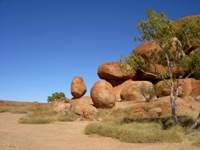Australia So Much to See


The Roadhouse and
After passing the roadhouse of Wauchope, seventeen kilometres further north the spinifex covered hills suddenly gives way to piles
of large boulders. This type of formation is hardly unique but here it is so different to the surrounding countryside. Ficus (fig trees) grow amongst the rock, and many rock piles are easy to climb. Friendly spinifex pigeons hop around the spinifex
clumps between the rock piles. The “Devil’s Marbles” in the Karlu Karlu Devil's Marbles Conservation Park is a spot worth
stopping for a while and marveling at balancing rocks and wondering how this cluster of rocks came to be here. The NT Parks
Devil's Marbles Campground is tucked away behind the rocks. Karlu Karlu means round boulders.
The large rest area at Bonney Well is near a bridge built in 1980 and at the site of an old well which was built on the site of a
native well. Like Ryans Well, there is a brick structure around the now disused well and here the wooden poles from the headframe
at the top are still standing. Signage explains the whip process of drawing water. The windmill which stands out as a
landmark is no longer functional and the tank alongside empty. There are tanks in the picnic area providing water for travellers
and campers, which must to be carted in. The old road runs alongside the new, with a low level old crossing dwarfed by
the new bridge. The nearby railway bridge spans a huge valley. Read the history of Bonney Well here
Just north of Bonney Well, we turned onto the Kurundi Road; a wide well maintained but stony road heading east, on our way to Old
Police Station Waterhole on the Frew River, in the Davenport Ranges National Park. A track via Ali Curung settlement which leaves
the Stuart Highway nineteen kilometres south of Wycliffe Well is an alternative route to Old Police Station Waterhole, but one
we did not take as it was not recommended for vehicles towing.
The stony hills reminded me of the hills in the former gold mining area of Arltunga, and I noticed that Kurundi Station advertise gold fossicking. We passed the turnoff to a campground at Whistleduck Waterhole, as we were heading for a bigger waterhole.
Considering the distance from the
Returning to the
The narrow watercourse known as Tennant Creek was named in 1860 by the explorer John McDouall Stuart. Long before, this was
a reliable source of water for local Aboriginal people.
The Battery Hill Mining and Visitor Centre with mining displays and underground tours is a little way along
The geology of the Tennant Creek area is very unusual in that the economic minerals – gold, copper and bismuth – are in most
cases associated with ironstone whereas in other goldfields the gold is more commonly associated with quartz.
The Waterhole at Old Police Station was large and birds of all types were abundant. We identified 26 different species. Weiros
(cockatiels) and budgerigars nested in the shady trees along the water’s edge. Clouds of white Corellas flew up and down the
river in formation, turning simultaneously in graceful waves. At night, feral donkeys come braying around the Old Police Station
Waterhole Campsite startling campers, and dingoes can sometimes be seen or heard.
Although fish can be caught, no-one had any luck when we were there which was put down to the season – fish are on the bite in summer
rather than winter, although someone found a few tiny crabs when they tried a prawn net. Even a group of families from the Wutunarrgurra
community had no luck at fishing using a drop net which yielded only a few very tiny ones that were put back.
In the late 1890s, drovers arrived at
There are other pools along the river, and some of these can be accessed by campers from the Frew River four wheel drive track which
goes to Hatches Creek former Tungsten (Wolfram) mine, where the track joins the road which forms part of the Binns Track, so a loop
drive can be taken through this sometimes narrow track, and return to the waterhole via the road. The
Water supplies were transported to Tennant Creek twice per year from Port Augusta. Beef and vegetables were grown on site, and
cattle yards still remain at the Old Telegraph Station and appear to have been upgraded in recent times for use for cattle from a
nearby cattle station.
To the north of the town, the buildings at the Old Telegraph Station have been partially restored. Following the move of the
Overland Telegraph Line station to the town, the buildings were used as a homestead up until 1985. A small graveyard includes
the graves of Overland Telegraph linesmen Archibald Cameron and Bryan (Tom) Nugent from Banka Banka Station. Read about Tom
Nugent - A station owner with a shady past here
About 120 mines are recorded in the area. The mineralization to 1996 has yielded approximately 130 tonnes of gold, 270,000
tonnes of copper and 14,000 tonnes of bismuth. However virtually all of the production has come from a few of the larger mines.
Tennant Creek Telegraph Station was one of eleven repeater stations along the line between Darwin and Port Augusta. The
first station was a temporary timber and bush structure built in 1872. More substantial buildings were constructed in the following
years. During its time as a telegraph station, the site became a haven for travelers, a post office and ration depot for Aboriginal
people. The town of
During World War Two, the Australian Army established a staging camp nearby for northbound convoys of troops and supplies. A local grazier purchased the Station in 1951 and one of the rooms became a Butcher’s shop. In 1986, the Northern Territory
Government acquired Tennant Creek Telegraph Station. It is now managed for conservation and education.
In 1897, Jerome Murif was the first man to cycle across
Not far from the Old Telegraph Station is a five kilometre track heading west to Kunjarra, a site of cultural significance as a women’s
place. Dancing and healing rites of the Munga Munga dreaming take are held here. This series of stone ridges is shown
as “The Pebbles” on maps.
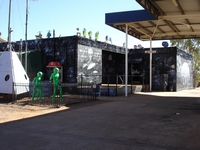
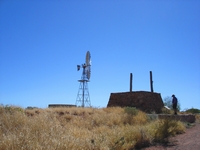
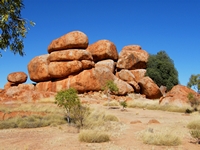
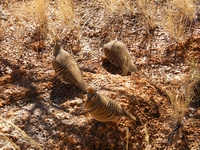
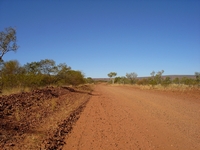
Heading south from Epenarra on part of the Binns Track we met a section of loose sandy patches which were not easy to drive through
when towing a caravan. At the turnoff to the Old Police Station Waterhole in the
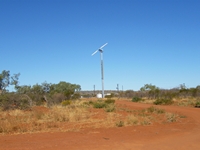

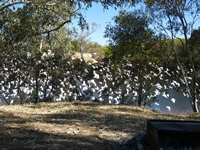
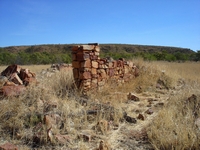
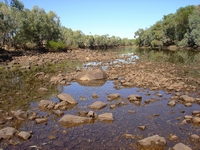
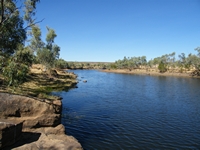
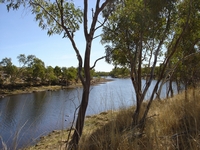
A walk trail goes right around this pool, which is one and a half kilometres long. On the other side of the pool are the ruins
of the Old Police Station which gives the waterhole its name. These remnants are of walls made from local stone with no mortar
used.
